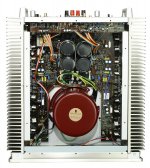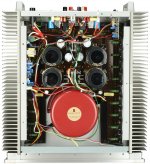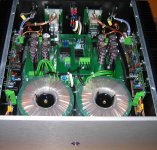You are always welcome, if you find yourself here just call and we can arrange a visit.
We had toads, lava-lamps, gargoyles, and turn-tables too.
Someday I will take you up on that...
Holy mackeral, I had two of those cassette decks..I think it was '79.
TTables? and a mixer? Hey, I'll bring in a coupla hundred 12 inch singles from the late 70's and a pair of of technics SL 5100's (direct drive, like a mack truck but doesn't cog when you slow or speed it by hand.) Sorry, no mirror ball and no dry ice.
The sliders on that mixer still work?? In the club, sliders lasted about a year tops..
jn
Yesterday I promised more on the designer assigned differences in different power amps depending on price point. Here goes:
The 3 main amps I would like to compare are my own:
There are many other examples, but I know my own designs better, so I will stick to them.
First, what they have in common:
They all have the SAME CIRCUIT TOPOLOGY
That is: The complementary differential jfet input stage.
They have a similar power supply
That is: unregulated toroid power transformer and semi regulated driver supply.
They are all fully complementary, through-out.
They do NOT have an output coil
They use output relay protection
They are all servo'd and have no input or interstage caps.
The price range of these 3 amps ranges from $1000, $2500, $9000 respectively.
How and why the prices are so different, will be explained in another input, along with the performance tradeoffs that go with it.
The 3 main amps I would like to compare are my own:
There are many other examples, but I know my own designs better, so I will stick to them.
First, what they have in common:
They all have the SAME CIRCUIT TOPOLOGY
That is: The complementary differential jfet input stage.
They have a similar power supply
That is: unregulated toroid power transformer and semi regulated driver supply.
They are all fully complementary, through-out.
They do NOT have an output coil
They use output relay protection
They are all servo'd and have no input or interstage caps.
The price range of these 3 amps ranges from $1000, $2500, $9000 respectively.
How and why the prices are so different, will be explained in another input, along with the performance tradeoffs that go with it.
First, the nominal 8 ohm rated power is: 100W, 250W, and 400W respectively. This means that the power supply voltage might range from 55V to 90V, yet there is a 9 times difference in price! This is where people start to wonder, but it is necessary.
For the record, I use the 100W described here in my video system, and I use a previously designed model of the 250W in my main hi fi system, along with the CTC Blowtorch. It is a 'weak link' but it is still listenable.
I will not put the 400W amp in my system because it is just too big and TOO POWERFUL for the WATT speakers that I use. However, it both measures and sounds better than the amp I am presently using.
Now what creates the physical differences between the amps?
The number of output pairs comes to mind. 2pr, 4pr and 9pr per channel of essentially the same output devices, respectively.
Heatsink size is significant between the amps, allowing the big power amp (JC-1) to have 25W (into 8 ohms) of Class A power, before going into Class AB mode to full output.
The middle amp, might have 2W, if properly biased of Class A, operation.
The small amp might have .5W or less, if properly biased of Class A, operation.
For serious listeners, this is critical, because higher order harmonics virtually always appear when you reach Class AB operation. They may be low in absolute value, but they are plain as day with good test equipment.
This is an advantage that good tube equipment has over solid state.
For the record, I use the 100W described here in my video system, and I use a previously designed model of the 250W in my main hi fi system, along with the CTC Blowtorch. It is a 'weak link' but it is still listenable.
I will not put the 400W amp in my system because it is just too big and TOO POWERFUL for the WATT speakers that I use. However, it both measures and sounds better than the amp I am presently using.
Now what creates the physical differences between the amps?
The number of output pairs comes to mind. 2pr, 4pr and 9pr per channel of essentially the same output devices, respectively.
Heatsink size is significant between the amps, allowing the big power amp (JC-1) to have 25W (into 8 ohms) of Class A power, before going into Class AB mode to full output.
The middle amp, might have 2W, if properly biased of Class A, operation.
The small amp might have .5W or less, if properly biased of Class A, operation.
For serious listeners, this is critical, because higher order harmonics virtually always appear when you reach Class AB operation. They may be low in absolute value, but they are plain as day with good test equipment.
This is an advantage that good tube equipment has over solid state.
What else: Well: Power toroids are rated 500, 600, and 1800W respectively. They are definitely larger in volume and weight as the get more W. Another change happens as we increase power. We add separate drive voltage windings at higher voltage to make the amp more efficient, and the drive stage more stable.
Power supply Caps might be: 12,000 x 2, 24,000 x 2, and 66,000 x 2 respectively.
The cap 'quality' also increases, along with its voltage rating. Only premium quality audio grade caps are used in the JC-1 for example.
There are many other details that we notice but a typical engineer might not.
For example, better film bypass caps, better quality connectors and wire, better circuit board layout, etc, etc. These all add to the overall cost. (significantly)
But that is the essence of it.
Power supply Caps might be: 12,000 x 2, 24,000 x 2, and 66,000 x 2 respectively.
The cap 'quality' also increases, along with its voltage rating. Only premium quality audio grade caps are used in the JC-1 for example.
There are many other details that we notice but a typical engineer might not.
For example, better film bypass caps, better quality connectors and wire, better circuit board layout, etc, etc. These all add to the overall cost. (significantly)
But that is the essence of it.
Now, why do we need such an extreme price range?
Well, nominal specs don't tell everything. For example, some very high quality loudspeakers, like huge electrostatics, require lots of voltage swing, AND low impedance high frequency drive. Therefore, an amp like the JC-1 is necessary to drive this sort of loudspeaker. Also, some very high quality direct radiator or magneplanar loudspeakers are very inefficient and require lots of power. Some loudspeakers actually are less than 4 ohms in average loading, and they require lots of current drive. These are all perfect for the JC-1.
The 250 W amp is fine for medium sensitivity direct radiators like my WATT or similar speakers with sensitivity hovering around 90spl @ 1W/meter. More power would just endanger the speaker, perhaps blowing a driver.
For example, if I put the JC-1 on my WATT's the peak power would be between 800 and 1000W, just too much.
Now what do we trade off when we reduce the power and the peak current drive?
I think, in these examples, it is the Class A range that becomes severely restricted due to a smaller heatsink, is the biggest problem. Unfortunately, all else being equal is not true with these 3 amps. IF the Class A range could be maintained in the 250W amp, then they would be essentially identical, (except for passive parts), but this would have increased the cost at least $500. Would it be worth it? Depends on your sensitivity to amps.
Finally the 100W amp. It is virtually stripped bare of just about everything possible, and still maintain the integrity of the design, and still meet 'spec's. It is not my best, but I have been using one for years as a TV adjunct amp with 2 pairs of Sequerra loudspeakers. Works just fine for TV sound. Sure beats the TV, that's for sure. That's about all I can say, pick and choose, just like you might buy an auto. You know, Civic, Acura, or BMW? You chose.
Well, nominal specs don't tell everything. For example, some very high quality loudspeakers, like huge electrostatics, require lots of voltage swing, AND low impedance high frequency drive. Therefore, an amp like the JC-1 is necessary to drive this sort of loudspeaker. Also, some very high quality direct radiator or magneplanar loudspeakers are very inefficient and require lots of power. Some loudspeakers actually are less than 4 ohms in average loading, and they require lots of current drive. These are all perfect for the JC-1.
The 250 W amp is fine for medium sensitivity direct radiators like my WATT or similar speakers with sensitivity hovering around 90spl @ 1W/meter. More power would just endanger the speaker, perhaps blowing a driver.
For example, if I put the JC-1 on my WATT's the peak power would be between 800 and 1000W, just too much.
Now what do we trade off when we reduce the power and the peak current drive?
I think, in these examples, it is the Class A range that becomes severely restricted due to a smaller heatsink, is the biggest problem. Unfortunately, all else being equal is not true with these 3 amps. IF the Class A range could be maintained in the 250W amp, then they would be essentially identical, (except for passive parts), but this would have increased the cost at least $500. Would it be worth it? Depends on your sensitivity to amps.
Finally the 100W amp. It is virtually stripped bare of just about everything possible, and still maintain the integrity of the design, and still meet 'spec's. It is not my best, but I have been using one for years as a TV adjunct amp with 2 pairs of Sequerra loudspeakers. Works just fine for TV sound. Sure beats the TV, that's for sure. That's about all I can say, pick and choose, just like you might buy an auto. You know, Civic, Acura, or BMW? You chose.
Sorry, no mirror ball and no dry ice.
The sliders on that mixer still work?? In the club, sliders lasted about a year tops..
jn
The mirror ball was at the other end of the room. The DJ was at KLAX in the 70's, the host DJ'd at Thule Greenland in the Vietman era (Air Force) and still has the reel to reel's of the playlists. He swears he told the recruiter, "ANYWHERE that there is no shooting".
Last edited:
The mirror ball was at the other end of the room.
I worked a club from 78 to 81 up in that really small state..
Had I known, I'd a sent some woofs to ya. I had a pair of PAS 15's and PAS 18's gathering dust. I gave them away.
I still have a dynaco 400, last time I turned it on it worked..also 3 sl 220 belt drive tt's. Belts corroded, motors spin..
jn
Last edited:
Yesterday I promised more on the designer assigned differences in different power amps depending on price point. Here goes:
Let's watch some pictures, if you do not mind. Hélas, one of them is probably not Parasound
Attachments
The problem for today is that middle men are becoming a thing of the past. China (and others to follow) will ship direct from factory to your door..... best possible price and no importer/distributor/retailer mark-ups for the consumer to pay. First went the factories, next the retail stores? -RNM
There was around 20 electronic shops selling components in Paris, at this time it was half the price to build a device from spare parts than to buy a finished product.The problem for today is that middle men are becoming a thing of the past. China (and others to follow) will ship direct from factory to your door..... best possible price and no importer/distributor/retailer mark-ups for the consumer to pay. First went the factories, next the retail stores? -RNM
Now, only two shops remain, they are outpriced and nothing inside. So, i'm obliged to get my components and parts from china or US, and building something is 10X the price of the same device from mass production.
The problem for today is that middle men are becoming a thing of the past. China (and others to follow) will ship direct from factory to your door..... best possible price and no importer/distributor/retailer mark-ups for the consumer to pay. First went the factories, next the retail stores? -RNM
Keep production plants, like they try in Germany. It was utterly stupid and short-eyed to move everything to Asia.
I mourn the loss of the corner HiFi shop.The problem for today is that middle men are becoming a thing of the past.
NEVER buy a speaker YOU haven't listened to .. regardless of what the Golden Pinnae at Stereophile or TAS say .. or even what true golden pinnae like John Atkinson say. You MUST use your own music and trust YOUR ears.
What's happened to the shops that would let you have stuff on extended approval before purchase.
But all is not lost. I see at least one Chinese online retailer of valve amps in the UK sells only on approval.
What's the betting the next JC will be from the PRC?
About little shops, it's a little complicated to pick and sell resistors, while, even in 70, in the factory i was working in, it was more expensive to fix a strap than a resistance on a board.Keep production plants, like they try in Germany. It was utterly stupid and short-eyed to move everything to Asia.
About production plants, i am sure they will be back soon, as the petrol price increase and quality is problematic with Asiat production while the production price increase with the elevation of the salaries . Hoping we will stay alive in between ?
More poetic, often, than realty useful. But, sometimes, nice trasfos and caps from military surplus, some old and nice loudspeakers and stuff you buy without any need because they are so beautifulWell, Esperado, at least you might have gained an appreciation for mil quality parts by shopping in a surplus outlet.
It is hard to buy Chinese stuff in line, as looking and feeling the real part is important for me. Good surprises with very low prices, bad ones with fake components.
Last edited:
I don't remember the birds, but the shop was still here some years ago.Or did I dream all of that? So long ago .....
- Status
- Not open for further replies.
- Home
- Member Areas
- The Lounge
- John Curl's Blowtorch preamplifier part II


